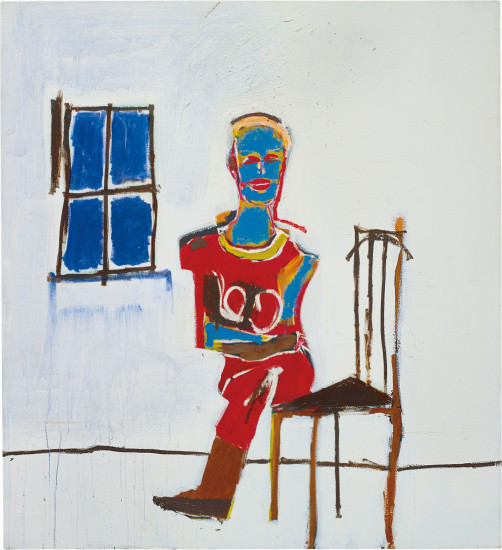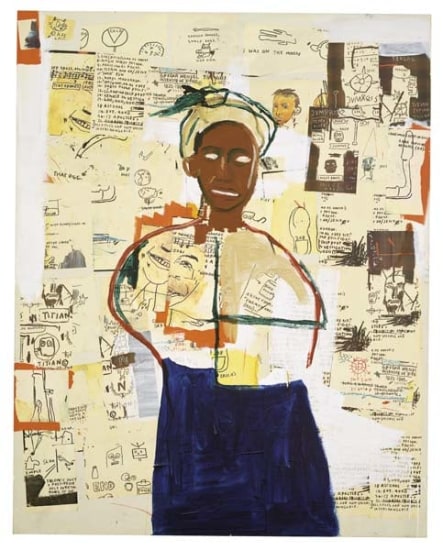Jean-Michel-Basquiat Krong Thip (Torso) 1983 acrylic, oilstick on canvas 66 1/8 x 60 1/8 in. (168 x 152.7 cm) Titled "Torso" lower right; further signed, titled and dated "Nov 1983" on the reverse.
Provenance Sidney Janis Gallery, New York The Estate of Marjorie Leshaw, New York Sotheby's, New York, Contemporary Art, May 13, 2004, lot 448 Private Collection Sotheby's, New York, Contemporary Art, May 11, 2006 Acquired at the above sale by the present owner Exhibited Seattle, Seattle Art Museum, States of War: New European and American Paintings, April - June 1985 Literature States of War: New European and American Paintings, exh. cat., Seattle Art Museum, Seattle, 1985, p. 23 (illustrated) Video Jean Michel Basquiat 'Krong Thip (Torso)', 1983 Perhaps best known for his derivative street style, 'Krong Thip (Torso)', 1983 is a rare example of Basquiat subscribing to traditional modes of rendering human anatomy. This lot depicts a human muscle study of the back and upper limb that is rich with reference to the proportional figure studies drawn by old masters, yet painted in the archetypal Basquiat process and exhibiting his instantly recognizable color application technique as exemplified by the vibrant interplay of white, blue, pink, red, yellow and orange on the canvas. Catalogue Essay Krong Thip (Torso) executed in 1983 shows Jean-Michel-Basquiat during the second creative phase of his eminent career, having recently graduated from subways to white cube spaces and assuming his position as a prodigy on the international art scene. Known for his powerful compositions which ignore academic rules and compositional hierarchies, Basquiat drew inspiration from everyday life and mixed media. Famously sampling elements from a wide range of source material such as symbol books, comic books quotations, music, African American culture, art history and anatomy and re-mixing them on canvas. Perhaps best known for his derivative street style, Krong Thip (Torso), 1983 is a rare example of Basquiat subscribing to traditional modes of rendering human anatomy. This lot depicts a human muscle study of the back and upper limb that is rich with reference to the proportional figure studies drawn by old masters, yet painted in the archetypal Basquiat process and exhibiting his instantly recognizable color application technique as exemplified by the vibrant interplay of white, blue, pink, red, yellow and orange on the canvas. This unusual subject matter aligns itself with the recurring motif of anatomical components within Basquiat’s oeuvre, inclusively tied to an enigmatic combination of words and symbols that collectively characterize his unique visual aesthetic. Unlike many Basquiat compositions which depict figures engaged in actions or which exude overt political or social associations, the labels “TORSO” and “LEFT HAND” alongside the figure are clear references to anatomical drawings and figure studies from the renaissance in which specific body parts were illustrated in isolation in order to enhance the artist’s understanding of anatomical precincts and contribute to the creation of more dynamic compositions. Set against the dominant red background, the vibrancy of the yellow torso isolates itself from the rest of the composition as the focal point. The sculptural rendering of the torso derives from Basquiat’s fascination with Leonardo Da Vinci’s notebooks, which provided a great source of inspiration throughout his career. The protruding shoulder blades and chiseled core indicate an idealized physique rendered in the classical style, while the cyan and black brushstrokes upon the torso depict a muscular form reminiscent of the deep shadowing and highlights employed by Da Vinci in his topographic notebook studies of human musculature. These accentuated lines adhere to anatomical rules of movement to produce the illusion of three-dimensionality on the canvas. Stretching out from the torso itself, the outline of an outstretched arm concluding in a geometric grid form is an allusion to Da Vinci’s comparative anatomical figure studies that employ mathematics to theories of body proportion. The blue and yellow numbers illustrated above the left
Jean-Michel-Basquiat Krong Thip (Torso) 1983 acrylic, oilstick on canvas 66 1/8 x 60 1/8 in. (168 x 152.7 cm) Titled "Torso" lower right; further signed, titled and dated "Nov 1983" on the reverse.
Provenance Sidney Janis Gallery, New York The Estate of Marjorie Leshaw, New York Sotheby's, New York, Contemporary Art, May 13, 2004, lot 448 Private Collection Sotheby's, New York, Contemporary Art, May 11, 2006 Acquired at the above sale by the present owner Exhibited Seattle, Seattle Art Museum, States of War: New European and American Paintings, April - June 1985 Literature States of War: New European and American Paintings, exh. cat., Seattle Art Museum, Seattle, 1985, p. 23 (illustrated) Video Jean Michel Basquiat 'Krong Thip (Torso)', 1983 Perhaps best known for his derivative street style, 'Krong Thip (Torso)', 1983 is a rare example of Basquiat subscribing to traditional modes of rendering human anatomy. This lot depicts a human muscle study of the back and upper limb that is rich with reference to the proportional figure studies drawn by old masters, yet painted in the archetypal Basquiat process and exhibiting his instantly recognizable color application technique as exemplified by the vibrant interplay of white, blue, pink, red, yellow and orange on the canvas. Catalogue Essay Krong Thip (Torso) executed in 1983 shows Jean-Michel-Basquiat during the second creative phase of his eminent career, having recently graduated from subways to white cube spaces and assuming his position as a prodigy on the international art scene. Known for his powerful compositions which ignore academic rules and compositional hierarchies, Basquiat drew inspiration from everyday life and mixed media. Famously sampling elements from a wide range of source material such as symbol books, comic books quotations, music, African American culture, art history and anatomy and re-mixing them on canvas. Perhaps best known for his derivative street style, Krong Thip (Torso), 1983 is a rare example of Basquiat subscribing to traditional modes of rendering human anatomy. This lot depicts a human muscle study of the back and upper limb that is rich with reference to the proportional figure studies drawn by old masters, yet painted in the archetypal Basquiat process and exhibiting his instantly recognizable color application technique as exemplified by the vibrant interplay of white, blue, pink, red, yellow and orange on the canvas. This unusual subject matter aligns itself with the recurring motif of anatomical components within Basquiat’s oeuvre, inclusively tied to an enigmatic combination of words and symbols that collectively characterize his unique visual aesthetic. Unlike many Basquiat compositions which depict figures engaged in actions or which exude overt political or social associations, the labels “TORSO” and “LEFT HAND” alongside the figure are clear references to anatomical drawings and figure studies from the renaissance in which specific body parts were illustrated in isolation in order to enhance the artist’s understanding of anatomical precincts and contribute to the creation of more dynamic compositions. Set against the dominant red background, the vibrancy of the yellow torso isolates itself from the rest of the composition as the focal point. The sculptural rendering of the torso derives from Basquiat’s fascination with Leonardo Da Vinci’s notebooks, which provided a great source of inspiration throughout his career. The protruding shoulder blades and chiseled core indicate an idealized physique rendered in the classical style, while the cyan and black brushstrokes upon the torso depict a muscular form reminiscent of the deep shadowing and highlights employed by Da Vinci in his topographic notebook studies of human musculature. These accentuated lines adhere to anatomical rules of movement to produce the illusion of three-dimensionality on the canvas. Stretching out from the torso itself, the outline of an outstretched arm concluding in a geometric grid form is an allusion to Da Vinci’s comparative anatomical figure studies that employ mathematics to theories of body proportion. The blue and yellow numbers illustrated above the left

.jpg)









Testen Sie LotSearch und seine Premium-Features 7 Tage - ohne Kosten!
Lassen Sie sich automatisch über neue Objekte in kommenden Auktionen benachrichtigen.
Suchauftrag anlegen